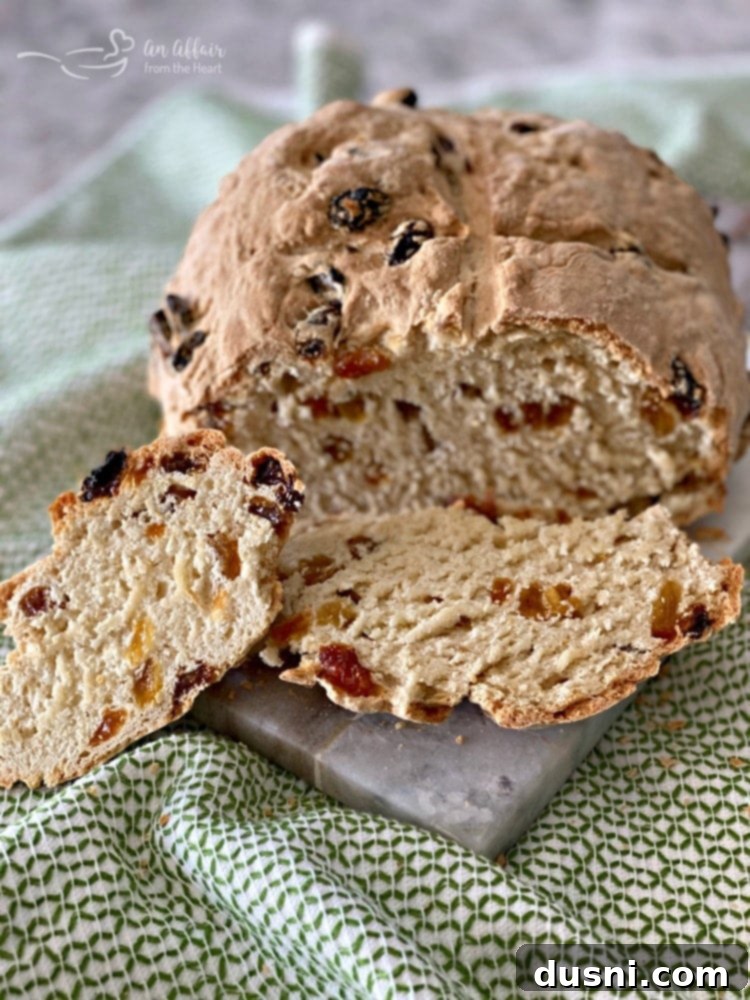Delicious Homemade Irish Soda Bread with Raisins: An Easy, Traditional Recipe
Experience the warmth and tradition of authentic Irish Soda Bread, generously dotted with plump, sweet raisins. This beloved classic boasts a delightfully crunchy exterior, giving way to a dense yet incredibly soft interior. Perfectly sweet and satisfying, it’s a wonderful addition to your favorite hearty soups, comforting stews, or any festive St. Patrick’s Day celebration!

Irish Soda Bread stands as a testament to simple, wholesome baking. What makes it truly remarkable is its ease of preparation – no yeast, no lengthy proofing, and minimal kneading mean you can have freshly baked bread on your table in just over an hour. This somewhat sweet white bread is characterized by its signature crusty exterior and a tender, soft crumb. While often studded with sweet raisins, you might also find traditional versions featuring earthy caraway seeds. The magic happens with everyday pantry staples: flour, a touch of sugar, baking soda, baking powder, and the essential ingredient, buttermilk.
The Secret Behind Soda Bread: Baking Soda & Buttermilk
The unique name “Soda Bread” comes from its primary leavening agent: baking soda. In Ireland, it’s even affectionately known as “bread soda.” Unlike yeast breads that rely on fermentation, soda bread uses the chemical reaction between baking soda (an alkali) and an acid, typically buttermilk. When these two ingredients combine, they produce carbon dioxide bubbles, which are trapped in the dough, causing the bread to rise quickly and efficiently without any waiting time. This ingenious method made soda bread a staple in Irish households, particularly during times when ovens and reliable yeast were less common.
Beyond its scientific marvel, Irish Soda Bread is a cultural icon, deeply rooted in the history and culinary traditions of Ireland. It’s more than just a recipe; it’s a comforting symbol of home and hospitality, especially significant around St. Patrick’s Day.
This delightful bread is a truly versatile accompaniment to a variety of dishes. It’s a perfect match for the traditional Corned Beef & Cabbage meal, offering a slightly sweet contrast to the savory main course. However, its applications extend far beyond St. Patrick’s Day. Imagine a warm slice, slathered with butter, served alongside a steaming bowl of creamy soup – just like the inviting Creamy Corned Beef & Cabbage Soup pictured here. Its sturdy yet soft texture makes it ideal for soaking up broth or stew, adding an extra layer of flavor and comfort to every bite.
My Journey with Homemade Irish Soda Bread
My personal connection to Irish Soda Bread deepened through my involvement with our church’s Food Committee. Being part of St. Patrick’s Parish, St. Patrick’s Day is naturally a momentous occasion for us. Each year, the church hosts a special dinner, and the demand for homemade Irish Soda Bread is always high. When I first embarked on this baking adventure, bread making felt a little daunting. Apart from the occasional Banana Bread, I hadn’t ventured much into the world of loaves and rolls.
However, I decided to give it a try, drawn by the simplicity of soda bread and its promise of quick results. What truly captivated me about this particular recipe was its subtle sweetness, derived from a modest amount of sugar and, of course, the juicy raisins. I confess, I’m a huge fan of raisins! Over the years, I’ve experimented with both regular and golden raisins, finding that either works beautifully, depending on what I have readily available in my pantry. Both varieties contribute that lovely burst of sweetness and chewy texture that makes this bread so irresistible.
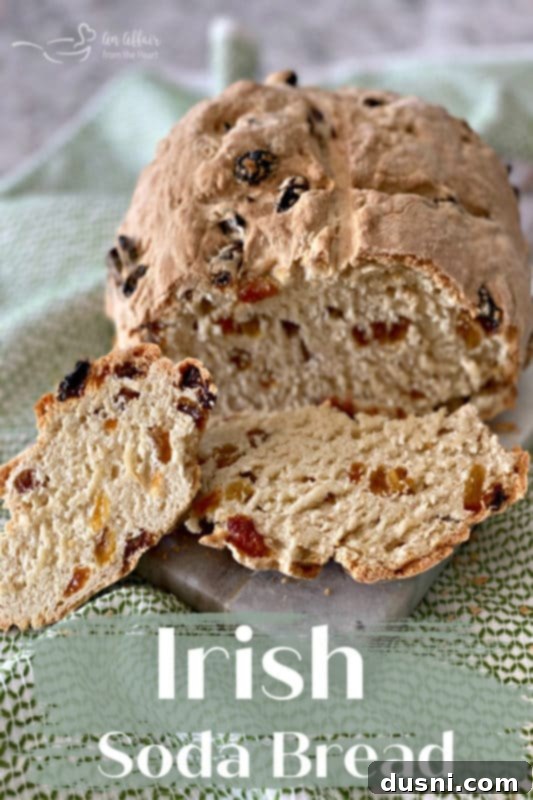
^Love it? Pin it for Later!^
Don’t let this fantastic recipe get lost in your bookmarks! Before you continue, take a moment to pin this delicious Irish Soda Bread recipe to your favorite Pinterest board. This way, it will be super easy to find whenever that craving for homemade bread strikes!
Baking Success: Preparing Your Irish Soda Bread
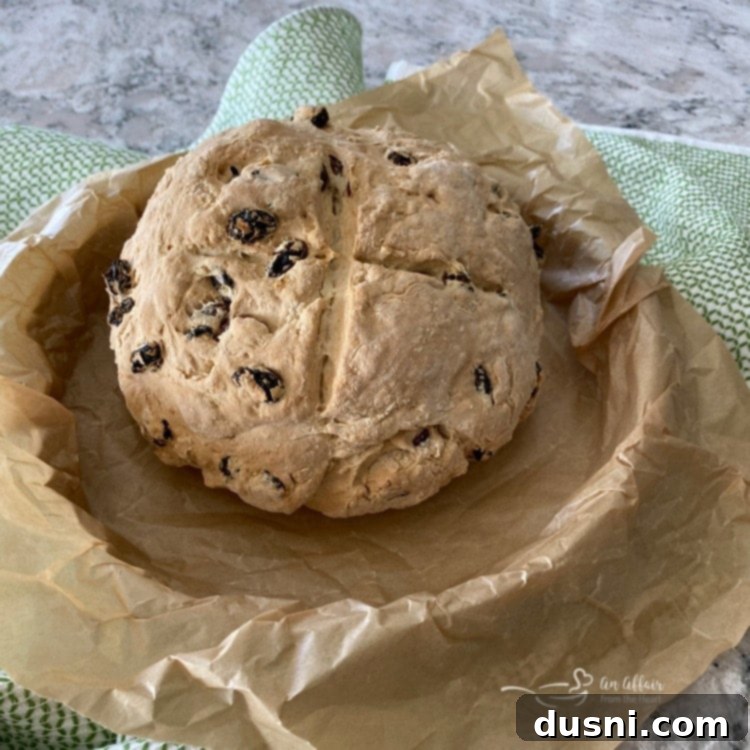
As I’ve highlighted, this Irish Soda Bread recipe is incredibly forgiving and straightforward. You absolutely don’t need to be an experienced bread baker to achieve fantastic results. The process is designed for simplicity, making it a perfect starting point for anyone looking to bake homemade bread without the complexities of yeast and extensive proofing.
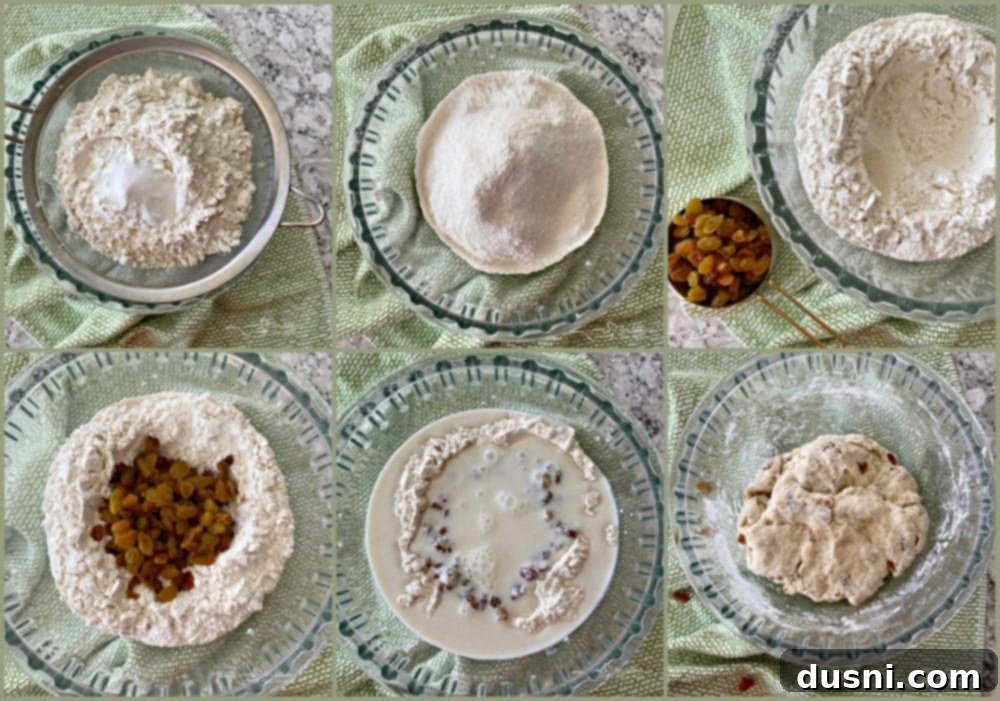
Begin by sifting your dry ingredients directly into a large mixing bowl. Sifting ensures that everything is evenly distributed and helps to aerate the flour, contributing to a lighter texture. Once sifted, create a “well” in the middle of the dry mixture. This helps in gradually incorporating the wet ingredients without overmixing. Add your chosen raisins (regular or golden work wonderfully here!), then pour in the buttermilk. Mix these ingredients just until they are combined. Don’t worry if the dough looks incredibly sticky – that’s perfectly normal and expected for soda bread dough!

Next, turn the sticky dough out onto a lightly floured board. Gently knead it about 10 times. The key here is *not* to over-knead. Unlike yeast breads that benefit from extensive kneading to develop gluten, soda bread relies on its chemical leavening, and too much kneading can lead to a tough, dry loaf. Once lightly kneaded, form the dough into a round circle and carefully place it into your parchment-lined cake pan. Using a sharp knife, score a distinctive “X” into the top of the dough. This traditional mark serves both aesthetic and practical purposes – it allows the heat to penetrate more evenly, ensuring a better rise and a beautiful, crusty finish. Then, it’s ready for the oven!
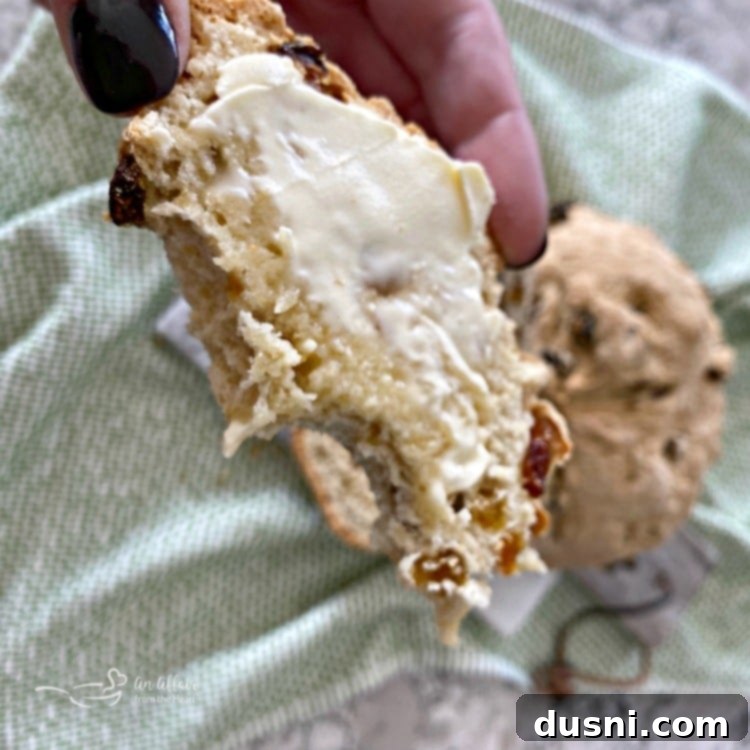
Once baked to golden perfection, you’ll be rewarded with a loaf that’s wonderfully crunchy on the outside and wonderfully dense and soft in the middle. The aroma alone is enough to get your mouth watering! Serve it warm, generously slathered with softened butter. For an extra treat, add your favorite jam or a drizzle of honey. And don’t forget, Irish Soda Bread is absolutely amazing toasted the next day, bringing back that delightful crispy crust and tender interior.
Simple Buttermilk Substitute: A Handy Trick
Many Irish Soda Bread recipes, including this one, call for buttermilk. However, for many home cooks, buttermilk isn’t a staple ingredient regularly kept on hand. I understand completely! While I use it in a few select recipes, it’s not enough to justify buying a whole quart only to use a fraction of it. This is why I often make my own Buttermilk Substitute. It’s incredibly easy to do: simply add a tablespoon of lemon juice or white vinegar to a liquid measuring cup, then fill it up to the desired amount with whole milk (or even a dairy-free alternative). Let it sit for 5-10 minutes until it curdles slightly. This quick hack ensures you always have “buttermilk” ready for your baking needs!

Homemade Cake Flour Substitute for a Lighter Crumb
Another ingredient this Irish Soda Bread recipe suggests is cake flour. Similar to buttermilk, cake flour might not be a common item in every home baker’s pantry. It’s a finely milled flour with a lower protein content, which results in a softer, more tender crumb – perfect for delicate baked goods like cakes and, indeed, this soda bread. If you don’t use cake flour frequently, it might expire before you get through an entire box. The good news is, you can easily make your own cake flour substitute at home using regular all-purpose flour and corn starch!
For this specific recipe, if you don’t have cake flour on hand, you can create a substitute by removing 6 tablespoons of all-purpose flour from the 3 cups called for, and then adding 6 tablespoons of corn starch to the remaining flour. Sift these together thoroughly to ensure the corn starch is evenly distributed. This simple trick will yield a texture very similar to store-bought cake flour, guaranteeing that delightful tender quality in your Irish Soda Bread.
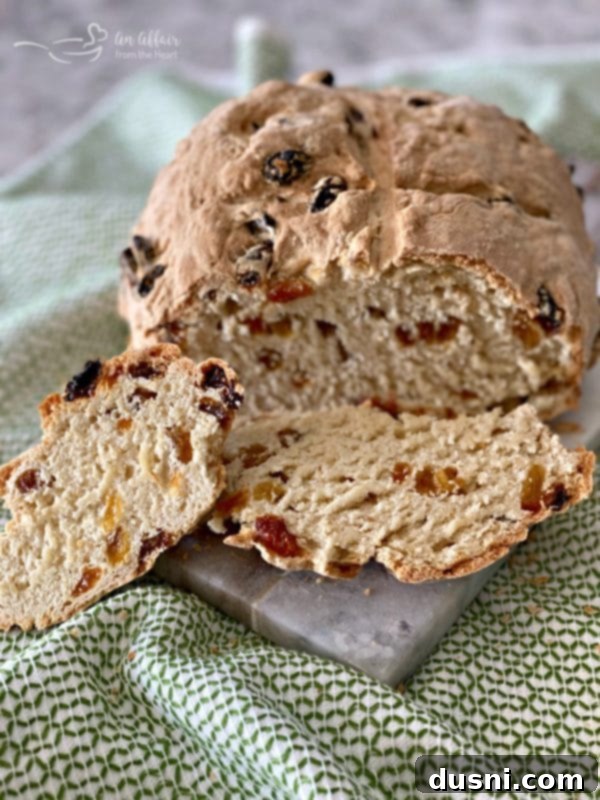
Tips for Perfect Irish Soda Bread Every Time
- **Don’t Overmix:** Overmixing develops gluten, which is great for chewy yeast breads, but makes soda bread tough. Mix just until combined.
- **Don’t Over-Knead:** A light, quick knead (about 10 times) is all you need to bring the dough together. Excessive kneading will activate gluten and result in a dense, rubbery bread.
- **Work Quickly:** Once the buttermilk and baking soda combine, the chemical reaction starts. Get the bread into the oven as soon as it’s shaped to maximize the rise.
- **Use Fresh Leavening Agents:** Ensure your baking soda and baking powder are fresh for the best rise.
- **Score Deeply:** The “X” cut on top should be fairly deep, about a third to halfway through the loaf, to allow for proper expansion during baking.
- **Trust Your Oven:** Ovens can vary. Keep an eye on the bread during the last 15-20 minutes of baking. It should be golden brown and sound hollow when tapped on the bottom.
Storing and Enjoying Your Loaf
Irish Soda Bread is best enjoyed fresh, ideally within 1-2 days of baking. Its soft texture and crust are at their peak shortly after coming out of the oven. To store, allow the bread to cool completely, then wrap it tightly in plastic wrap or aluminum foil, or place it in an airtight container at room temperature. For longer storage, you can slice the cooled bread and freeze individual slices, wrapped well, for up to a month. Thaw and toast as needed for a quick and delicious treat!
Variations to Personalize Your Soda Bread
While this raisin-studded recipe is a classic, Irish Soda Bread is wonderfully adaptable. Feel free to experiment with different additions to suit your taste:
- **Savory Options:** Incorporate shredded cheddar cheese and chives or other fresh herbs like rosemary or thyme for a savory loaf perfect with dinner.
- **Citrus Zest:** Add the zest of an orange or lemon along with the raisins for a brighter, more aromatic sweet bread.
- **Spices:** A pinch of cinnamon or nutmeg can add a lovely warmth to the sweet versions.
- **Other Dried Fruits:** Swap out raisins for dried cranberries, currants, or chopped dried apricots for a different flavor profile.
I have oodles of St. Patrick’s Day Recipes as well as Bread Recipes here on my blog, so please stay a while and give them a browse, won’t you? You’re sure to find more delicious inspiration for your kitchen!

Now, without further ado, let’s dive into this incredibly quick and simple Irish Soda Bread with Raisins recipe! You’ll be enjoying warm, fragrant, homemade bread in just over an hour. Happy baking! 
LIKE THIS RECIPE?
Don’t forget to give it a ⭐️⭐️⭐️⭐️⭐️ star rating and
leave a comment below the recipe!

Print Recipe
Irish Soda Bread
Ingredients
- 3 cups sifted cake flour *
- 3 Tablespoons of sugar
- 1/2 teaspoon baking soda
- 1/2 teaspoon baking powder
- 1 teaspoon salt
- 1 cup raisins regular or golden are fine
- 1 1/3 cup of buttermilk **
Instructions
-
Preheat oven to 350 degrees F (175 degrees C). Line a 9-inch cake pan with parchment paper.
-
Sift all of the dry ingredients (flour, sugar, baking soda, baking powder, salt) into a large mixing bowl. Form a “well” in the center of the flour mixture.
-
Add raisins and buttermilk to the well, and combine gently until just mixed. The dough will be STICKY.
-
Turn the dough onto a lightly floured board and knead very gently about 10 times. Do not over-knead.
-
Form the dough into a round circle, and place it into the prepared pan. Score a traditional “X” in the top with a knife.
-
Bake for 60-65 minutes, or until golden brown and a toothpick inserted comes out clean.
-
Cool slightly on a wire rack before slicing and serving.
Notes
** Buttermilk Substitute: If you don’t have buttermilk on hand, make your own! Combine 1 1/3 cups of whole milk with 1 tablespoon of lemon juice or white vinegar. Let it sit for 5-10 minutes until it slightly curdles. Find a detailed Buttermilk Substitute Recipe here.
Storage Tip: Bread WILL NOT KEEP for long. It is best consumed within 1-2 days for optimal freshness and texture.
Nutrition
This post was originally published in March of 2013 and was updated in March of 2020 to upgrade user experience and provide additional helpful tips. The core recipe is inspired by Green Eggs and Spam.
